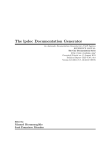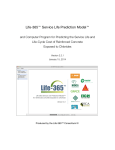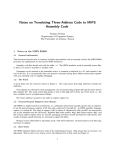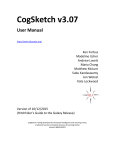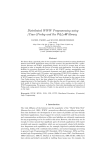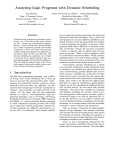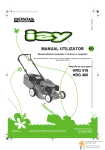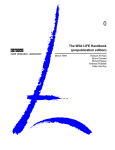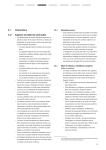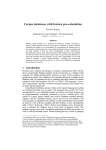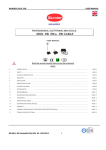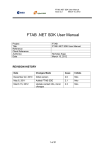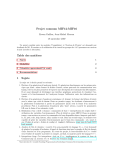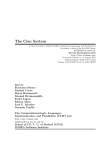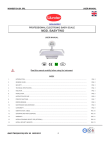Download Compiling Order-Sorted Feature Term Unification - Hassan Aït-Kaci
Transcript
7 digi tal PARIS RESEARCH LABORATORY Compiling Order-Sorted Feature Term Unification December 1993 Hassan Aı̈t-Kaci Roberto Di Cosmo PRL TECHNICAL NOTE 7 Compiling Order-Sorted Feature Term Unification Hassan Aı̈t-Kaci Roberto Di Cosmo December 1993 Publication Notes The work reported, belatedly, in this technical note is the result of the authors’ collaboration from September 1992 until December 1992, while Roberto Di Cosmo was visiting PRL from ENS to work as a student intern under the supervision of Hassan Aı̈t-Kaci. Current contact addresses of authors: Hassan Aı̈t-Kaci [email protected] Roberto Di Cosmo [email protected] School of Computing Science Simon Fraser University Burnaby, British Columbia V5A 1S6, Canada École Normale Supérieure Laboratoire d’Informatique 45 rue d’Ulm 75005 Paris, France c Digital Equipment Corporation 1993 This work may not be copied or reproduced in whole or in part for any commercial purpose. Permission to copy in whole or in part without payment of fee is granted for non-profit educational and research purposes provided that all such whole or partial copies include the following: a notice that such copying is by permission of the Paris Research Laboratory of Digital Equipment Centre Technique Europe, in Rueil-Malmaison, France; an acknowledgement of the authors and individual contributors to the work; and all applicable portions of the copyright notice. Copying, reproducing, or republishing for any other purpose shall require a license with payment of fee to the Paris Research Laboratory. All rights reserved. ii Abstract Order-sorted feature (OSF) terms generalize first-order rational terms: functors become partially ordered sorts, arity is unconstrained, and subterms are unordered, indicated by explicit feature symbols rather than implicit positions. Thus, OSF terms provide a handy data structure to represent objects in symbolic programming languages. LIFE is such an experimental language extending Prolog by replacing its term data structure and unification operation with OSF term and unification. In this paper, we present an abstract machine design for OSF term unification. This compiling scheme consists of an alteration of recent refinements of WAM technology for compiling Prolog’s unification. Our modifications account for order-sortedness, symbolic features, and absence of arity. Then, we improve that design by incorporating several immediate optimizations. Résumé Les termes à traits et à sortes ordonnées généralisent les termes rationnels de premier ordre : les symboles fonctionnels deviennent des sortes partiellement ordonnées. Ils n’ont pas de contrainte d’arité, et leurs sous-termes sont dans le désordre, indiqués par des symboles de traits explicites plutot que par des positions implicites. Ainsi, ces termes offrent une structure de données adéquate pour représenter des objets dans des langages de programmation symbolique. LIFE est un tel langage, étendant Prolog en remplaçant sa structure de données de terme et son opération d’unification par les termes à traits et sortes ordonnées et leur unification. Dans ce papier, nous présentons une maquette de machine abstraite pour l’unification de ces termes. Ce schéma de compilation consiste en une altération de la technologie WAM pour compiler l’unification de Prolog. Nos modifications prennent en compte l’ordre sur les sortes, les traits symboliques, et l’absence d’arité. Puis, nous améliorons cette maquette en y incorporant plusieurs optimisations immédiates. iii Keywords Unification, Prolog, LIFE, Warren’s abstract machine, Feature structures. iv Contents 1 Heap representation 1 2 Compiling query terms 3 3 Compiling program terms 3.1 3.2 The write sequence The read sequence : : : : : : : : : : : : : : : : : : : : : : : : : : : : : : : : : : : : : : : : : : : : : : : : : : : : : : : 4 Optimizations 4.1 4.2 4.3 4.4 Uneffective code : : : : : : : : : : : : : : : : Unreachable code : : : : : : : : : : : : : : : Unreachable labels and redundant write tests Compressing chains of write tests : : : : : : References : : : : : : : : : : : : : : : : : : : : : : : : : : : : : : : : : : : : : : : : : : : : : : : : : : : : : : : 7 10 11 12 12 17 17 17 20 v 1 Compiling Order-Sorted Feature Term Unification On the other hand, if it is true that regions gradually merge into one another, and this remains to be proved, then I may well have left mine many times, thinking I was still within it. SAMUEL BECKETT, Molloy This document describes an abstract instruction set for compiling order-sorted feature (OSF) term unification [4] as it is used in the LIFE language [2]. This set of instructions is being used as the basis for the compiler of LIFE currently under development at PRL [8]. For an introduction to OSF terminology and the unification rules, the reader is referred to [4, 3]. 1 Heap representation We consider a simple language consisting of two kinds of entities, both OSF terms: a query and a program. The operational semantics of this language amounts to unifying the query term with the program term. As in the case for Prolog, instructions compiling the query will build a representation for it in a memory area (called HEAP). However, the heap representation of OSF terms, will be different from that used in the WAM, because we will need to take into account the following additional elements that are specific of OSF terms: there is no difference between a structure and a variable (in particular each node may be dereferenced); every node in an OSF term has a sort information in lieu of the functor information of Prolog terms, and this information can be modified during unification; the arity of functors is no longer fixed, and subterms are accessed by feature name, and not just by position, as for the argument of a Prolog structure. A consequence of the first and second points is that the distinction between structure and variable made by the WAM heap representation is no longer appropriate: variables are just sorted coreference tags virtually attached to any subterm of a term and no longer restricted as leaves only. In particular, variables such as Prolog’s are implicitly sorted with , the greatest sort. Also, order-sorted unification can refine structures; for example, if the sort ordering is such that zero < zeropos and zero < zeroneg, them the terms zeropos and zeroneg can be unified, refining their sorts to zero. This means that in our heap representation, everything must be encoded uniformly. > The third point confronts us with the only real difficulty: during OSF unification, subterms identified by the same feature name must be unified. The problem is to perform this efficiently. This issue does not arise in Prolog because, there, subterms come with an associated natural order: the n-th subterm is the one coming in position n, so unification of two terms proceeds by structural decomposition: foo(first(a); second(int)) and foo(second(int); first(a)) are not unifiable. Technical Note No. 7 December 1993 2 Hassan Aı̈t-Kaci and Roberto Di Cosmo For OSF terms, on the contrary, subterms are identified by features names. So, for example, the two OSF terms foo(first a; second int) and foo(second int; first a) are not only unifiable, but actually identical. Thus, subterms must be unified not in the order they come, but as indicated by common feature names. What is worse, arity of OSF terms being unconstrained, it can vary dynamically through the unification process. So it is not possible to use at compile time, as the WAM does for Prolog, a fixed order for the feature names. ) ) ) ) This fact causes a major departure from the WAM heap term representation. It is necessary to abandon the convention of having the references to the n arguments of a functor stored exactly after it in n consecutive locations. What is needed is an alternative representation of the set of featured subterms that enjoys the following properties: fast associative access to, whether retrieval or insertion of, subterms via feature names; fast iteration over a set of feature names and their associated reference subterms; eventually for backtracking purposes, a small overhead for trailing operations and undoing them. One immediate drawback of associative access to subterms is that it is slower (even if not by much) than in the WAM where access is direct thanks to fixed arity constraints.1 On the other hand, the decoupling between the functor representation and the argument representation will allow us to adopt more flexible code generation schemes. Hence, for simplicity and generality, we will use abstract operations dealing with associative feature access to subterms. As an illustration of our OSF term representation, Figure 1 shows a heap representation of the OSF term: ) ) ) ) X : person(name id(first string; last Y : string); spouse person(name id(last Y ); spouse X)): ) ) ) (1) This representation is explained as follows. An OSF term is essentially a labeled sorted graph: the nodes contain sort and structure-sharing information and the edges are labeled with feature names. This justifies separating the conventional single heap area in memory into two: HEAP and FHEAP. The area HEAP is where nodes are stored and FHEAP contains tables associating feature names to nodes. Therefore a HEAP cell consists of three fields: CREF: the coreference field, an index into HEAP. This determines whether this term is unbound or bound to another. If it is unbound, the value of this field is the index of its own HEAP cell. 1 However, many optimizations are possible, that will not be discussed here, whereby global analysis, explicit pragmas, together with clever indexing techniques such as perfect hashing and/or cached feature access can provide for Prolog terms to be compiled virtually as efficiently as in Prolog [8]. December 1993 Digital PRL 3 Compiling Order-Sorted Feature Term Unification HEAP CREF 1 2 3 4 5 6 1 2 3 4 5 6 SORT FHEAP FTAB person t1 id t2 string NIL string NIL person t3 id t4 FEAT TERM t1 name spouse .. . 2 5 t2 first last 3 4 t3 .. . name spouse .. . t4 last 6 1 4 Figure 1 Heap representation of OSF term (1) SORT: the sort field, a (representation of) the sort symbol of the root of this term. FTAB: the feature table field, an index into FHEAP containing the association table between feature symbols and the node address in HEAP of the subterms. If there are no subterms, this field is set to NIL. Similarly, the feature heap FHEAP consists of tables whose entries are cells made out of two fields: FEAT: the feature field. TERM: the term field. This is a index into HEAP. In the following sections we will first see how to generate efficient code to build such representations and to perform unification on them, and then we will discuss some simple immediate improvements. 2 Compiling query terms Compiling a query term consists of generating a sequence of instructions that, when executed, will build its representation on the heap, ready to be used later for unification with a program term. As in Prolog, we start by flattening an OSF term into a list of simple tokens. Then, we choose an appropriate ordering for the tokens from which well-founded code may be generated. The tokens will no longer refer to the user level names of the variables, but only to internal variables Technical Note No. 7 December 1993 4 Hassan Aı̈t-Kaci and Roberto Di Cosmo known as registers. Those will play exactly the same role as the WAM’s so-called temporary registers and similarly denoted as X1 , X2 , etc. As in the WAM, X1 is always used for the root of the outermost term. The tokens making up an OSF term’s flattened form are of two kinds: X : s (X has sort s); X = X (X has feature i i :` i j i ` and it corresponds to Xj ). For example, the flattened form of OSF term (1) is given by the following sequence of tokens: X1 : person; X1 :name = X2 ; X2 : id; X2 :first = X3 ; X3 : string; X2 :last = X4 ; X4 : string; X1 :spouse = X5 ; X5 : person; X5 :name = X6 ; X6 : id; X6 :last = X4 ; X5 :spouse = X1 : If one follows the WAM approach, each token yields an abstract machine instruction building the corresponding piece of term on the heap. Namely: set cell X i; s This corresponds to the token Xi : s and has for effect to create a cell on the heap, set register Xi to its address, and set the sort field of this newly created cell to s. set feature Xi ; `; Xj This corresponds to the token Xi :` = Xj and has for effect to create an entry in the feature table of Xi for feature ` and set it to point to the address contained in register Xj . Note that set cell Xi ; s corresponds in fact to the combination of two WAM instructions: put structure Xi ; s and set variable Xi .2 This is due to the fact that structures and variables are now just one same thing. Similarly, set feature Xi ; `; Xj corresponds to set value Xj for the WAM, but with the need to declare explicitly which feature of which register we are setting, since the contiguous positional convention of WAM term representation is no longer sound. However, it is important to recognize that the set cell Xi ; s instruction is actually built out of two simpler instructions, which can used to produce better code. The set cell Xi ; s instruction really does two different things: push cell X : it pushes on the heap a new cell and reserves it to register X set sort X s: it initializes the sort field of this new cell to s. i i i; Now, if we keep the set cell Xi ; s instruction, this means that new heap cells are generated only in correspondence with a token Xi : s, while if we decompose it into push cell Xi and 2 Strictly speaking, using original WAM instructions, we should say unify variable Xi in write mode, rather than set variable Xi . However, we follow [1] using set instructions for queries rather than unify instructions with a systematic useless write mode test as done in [9]. December 1993 Digital PRL 5 Compiling Order-Sorted Feature Term Unification set sort Xi ; s, we have the possibility to create new cells at a different time. This is not only more natural, it simplifies code generation as no particular order must be imposed on the token sequence. Moreover, this gives the additional freedom to commute instructions, a technique that is often yielding relevant optimizations---we shall see later some examples. Our abstract instructions will be generated as follows from the token sequence: push cell X i This corresponds to a first seen Xi in a token (either an Xi : s or a Xi :` = Xj or a Xj :` = Xi ) and has for effect to push on the heap a new cell and stored its address in Xi . It is generated before any other instruction coming from the same token. set sort Xi ; s This corresponds to the token Xi and has for effect to set the sort field of the cell pointed to by Xi to s. set feature Xi ; `; Xj This corresponds to the token Xi :` = Xj and has for effect to create an entry in the feature table of Xi for feature ` and set it to point to the address contained in register Xj . The main advantage of this code generation schema is that it will produce correct code irrespective of the order of the tokens: indeed, it ensures that a set feature Xi ; `; Xj istruction will be generated only after a push cell Xi and a push cell Xj have been generated, and similarly for set sort Xi ; s instructions. Furthermore, this advantage is obtained at no cost: the operations performed by a push cell Xi and a set sort Xi ; s instructions amount exactly to the same work done by one set cell Xi ; s instruction. We are now free to choose the token ordering that best suits our compilation needs. Let us now consider the advantages of this compilation schema on the simple example of the OSF term X : loop(a(X)). Its flattened form is: X1 : loop; X1 :1 = X2 ; X2 : a; X2 :1 = X1 : Let us suppose that we want to follow the WAM compilation schema: it is clear that we must first generate the code to build the subterms of X1 , and then the code to build X1 . But doing so, we are forced to generate the code for X2 first, which requires in turn that X1 be already available. So we are apparently stuck here: it seems impossible to generate the code for a cyclic OSF term in one pass. Suppose now that we adopt the decoupling of representation of nodes and edges and we take the set cell Xi ; s instruction (and not its components push cell Xi and set sort Xi ; s) as primitive: it is then possible to generate the code in one single pass. Indeed, when features (arguments) of a sort (functor) are no longer required to be contiguous following that sort in the heap, one can reorganize the code generation for an OSF term of the form X : s(t1; : : : ; tn) as follows: Technical Note No. 7 December 1993 6 Hassan Aı̈t-Kaci and Roberto Di Cosmo set set set set cell X1 ; loop cell X2 ; a feature X2 ; 1; X1 feature X1 ; 1; X2 % % % % X1 : loop; X2 : a; X2 :1 = X1 ; X1 :1 = X2 : Figure 2 Code with set cell for query OSF term X : loop(a(X)) push cell X1 set sort X1 ; loop push cell X2 set feature X2 ; 1; X1 set sort X2 ; a set feature X1 ; 1; X2 % % % % % % X1 : loop; X1 : loop; X2 : a; X2 :1 = X1 ; X2 : a; X1 :1 = X2 : Figure 3 Code with push cell and set sort for query OSF term X : loop(a(X)) first, build the structure for X : s at address H in the heap and save it in a register X ; then, build the representation of the subterms t , already knowing the address X of X : s (which can be used even with cyclic references); finally, build the feature table of X : s, already knowing the addresses of each of the i k 3 i subterms. Hence, it is necessary to use the flattened token sequence in a specific order. This order must generate a set feature Xi ; `; Xj instruction only after the pair of instructions set sort Xi ; si and set sort Xj ; sj have been generated. For instance, the tokens for query in our previous example must be reordered thus: X1 : loop; X2 : a; X2 :1 = X1 ; X1 :1 = X2 and the corresponding abstract machine code for it is then shown in Figure 2. Finally, if we take push cell Xi and set sort Xi ; s as primitive instructions, the code generation proceeds flawlessly without any need to reorder the token stream. For instance, the code generated for the original token stream of the previous example is shown in Figure 3, and the code for the reordered token stream is shown in Figure 4: they are both valid and they both build the same structure on the heap. Notice that this last abstract instruction sequence will be translated in the very same pseudo--code as the sequence in Figure 2. 3 As in the WAM, we shall use a global register H to indicate the first free cell in HEAP. Similarly, a global register FH will indicate the first free address in FHEAP. December 1993 Digital PRL Compiling Order-Sorted Feature Term Unification push cell X1 set sort X1 ; loop push cell X2 set sort X2 ; a set feature X2 ; 1; X1 set feature X1 ; 1; X2 % % % % % % 7 X1 : loop; X1 : loop; X2 : a; X2 : a; X2 :1 = X1 ; X1 :1 = X2 : Figure 4 Code for query OSF term X : loop(a(X)) Going back to our OSF term 1, its flattened form can be directly translated into the abstract machine code shown in Figure 5. The effect of these instruction is described in Figure 6, so that, when executed, the code of Figure 5 will build the heap representation shown in Figure 1. The add feature operation (Figure 7) installs a new feature in a table, allocating a new table if necessary. 3 Compiling program terms Now that we know how to compile an OSF term query into executable code that will build its correct representation in memory, we can tackle the problem of generating code for a program; i.e., another OSF term to be unified with the query already built. Let us recall briefly the instructions used in the WAM to compile a program term. For simplicity, we will just focus on the general purpose instructions get structure f =n; Xi, unify variable Xi and unify value Xi , and not worry about their specialized versions for constants and lists. These basic instructions can work essentially in two modes: read mode---this is the default mode, in which the instructions check that the term on the heap matches the program term; write mode---this is the mode in which the instructions build on the heap a copy of (a portion of) the program term, binding a variable in the query term. Taking advantage of the sequential and contiguous representation of the argument of a functor in memory, these instructions use a specialized register S (next subterm) together with a global mode flag to switch back and forth from one mode to the other. The get structure f =n; Xi instruction is in charge of this switching: it always checks if the memory location indicated by Xi contains a structure or a variable. If it finds a structure, it sets the mode flag to read and initializes S to the first subterm in the heap. The instructions following it in sequence, one unify instruction per subterm in the order they come, will then unify what S points to in the heap with the portion of the program term encoded by the instruction, and then increment S. If, on the other hand, get structure f =n; Xi finds a variable on the heap, it switches the Technical Note No. 7 December 1993 8 Hassan Aı̈t-Kaci and Roberto Di Cosmo push cell X1 set sort X1 ; person push cell X2 set feature X1 ; name; X2 set sort X2 ; id push cell X3 set feature X2 ; first; X3 set sort X3 ; string push cell X4 set feature X2 ; last; X4 set sort X4 ; string push cell X5 set feature X1 ; spouse; X5 set sort X5 ; person push cell X6 set feature X5 ; name; X6 set sort X6 ; id set feature X6 ; last; X4 set feature X5 ; spouse; X1 % % % % % % % % % % % % % % % % % % % X1 : person X1 : person X2 : id X1 :name = X2 X2 : id X3 : string X2 :first = X3 X3 : string X4 : string X2 :last = X4 X4 : string X5 : person X1 :spouse = X5 X5 : person X6 : id X5 :name = X6 X6 : id X6 :last = X4 X5 :spouse = X1 : Figure 5 Code for query OSF term (1) push cell Xi set sort Xi ; s set feature Xi ; `; Xj HEAP[H]:CREF HEAP[H]:FTAB Xi H; increment (H) H; NIL; HEAP[Xi ]:SORT s; add feature(HEAP[Xi ]:FTAB; `; Xj) Figure 6 Instructions for query terms December 1993 Digital PRL Compiling Order-Sorted Feature Term Unification 9 procedure add feature(table : address; feature : symbol; value : address); begin if table = NIL then begin FHEAP[FH] new table; FH; table increment (FH) end; put feature(table; feature; value) end add feature; Figure 7 The add feature operation mode flag to write, and the same unify instructions will then build on the heap the portion of the program term that must occur at that corresponding position (i.e., behave exactly as for a query term). Hence, these unify instructions test the mode flag to see if they have to match or build their bit of information on the heap. It is clear that for this to work, two conventions must be obeyed: (1) subterm cells must follow contiguously a functor cell on the heap and in the right order; and (2) exactly one unify instruction per subterm must be generated, contiguously and in the same order. Neither of these two conventions are observed in our representation and code generation. Nevertheless, it would not be difficult to adapt the basic idea to our setting, although at a cost. Recently, another scheme for compiling unification was devised which does not rely on contiguity conventions, and has the advantage of being more efficient than the original contiguity scheme. The gist of this method relies on the fact, as described in [7],4 that the original WAM contiguity scheme generates redundant work and, therefore, inefficiency. Indeed, every execution of a get structure f =n; Xi performs a complex test to determine if the machine must proceed in read or write mode. Namely, it always dereferences Xi and tests whether it is a variable or a structure, no matter where and when it is executed. As a result, this means that if the machine enters write mode to build a large term on the heap, it will continually and uselessly test the mode flag and dereference newly built variables just to discover that it has to keep on writing. To avoid this unnecessary overhead an optimization can remove redundant mode tests from the instructions. Rather than processing terms breadth-first as done by the WAM contiguity conventions, it is advantageous to proceed through a term depth-first. In this way, the mode flag need not be reset for a term once set to write at its root. Two streams of instructions, a 4 This method was in fact originally discovered as early as 1988 by Mohamed Amraoui, a doctoral student at Rennes, France [5]. Amraoui’s idea, since unpublished, seems to have gone unnoticed until it was apparently rediscovered independently by Micha Meier [7] and later optimized further by André Mariën and Bart Demoen [6]. It is the latter scheme that we shall adapt to our layout. Technical Note No. 7 December 1993 10 Hassan Aı̈t-Kaci and Roberto Di Cosmo write test Level; Label if D Level then goto Label Figure 8 Conditional jump out of write mode read stream and a write stream are thus generated, each adequately peppered by conditional jumps from one to the other depending upon whether the term since the last jump into the stream has been completely processed. A consequence of this is that different instructions must be used for different (read or write) modes. This entails using more, albeit lighter-weight, instructions. Moreover, these can further be arranged in such a way as to reduce tests for mode switching to the minimum necessary. This approach can be smoothly adapted to our case, and we will follow it in our design of the abstract machine. A program term will be compiled into two sequences of instructions: a write sequence consisting of exactly the same instructions used to compile a query term, and a read sequence consisting of instruction to perform appropriate unification with the heap. The problem posed by the depth-first organization of instructions is to insert tests and jumps properly in each sequence. Clearly, these must be placed at the boundaries marking the code for each subterm. They are logically where it is necessary to decide whether to carry on in the current mode (read or write), or jump to the other stream. Micha Meier’s instructions keep track of term boundaries using a rather complicated scheme. André Mariën and Bart Demoen proposed a simpler and better means to do the same. Their idea uses information given by the nesting depth of a term inside the outermost term being compiled. A global register D will be used to indicate, at execution time, the least depth encountered since the last stream jump. Thus, instructions ‘‘recognize’’ term boundaries by a simple comparison test of their own (statically known) depth and the depth register D. 3.1 The write sequence The write sequence is the simpler of the two; and this, for two reasons. Firstly, its writing instructions are exactly the same as the code produced for compiling a query. Secondly, once write mode is set, for a subterm this holds for all subterms underneath it. The idea is that execution of a program term starts in read mode. Whenever, at a given depth, it is found there that a subterm must be built, the register D is set to that depth and control jumps to the write subsequence corresponding to that term. Control will know when to return to the read sequence as soon as it reaches write instructions pertaining to a lesser level than the one indicated by D. Therefore, the appropriate place to test for a jump out of a write sequence is immediately after the last instruction corresponding to a subterm. This is achieved by placing the instruction write test Level; Label shown in Figure 8 at the end of the code sequence for each subterm of depth Level. The label Label is the address of the first instruction in the code of the read stream which corresponds to the next appropriate subterm where to resume in read mode. Namely, that of the next subterm of depth lower or equal to that of the December 1993 Digital PRL Compiling Order-Sorted Feature Term Unification 11 subterm just written. 3.2 The read sequence Now, regarding the read sequence of a program term, its instructions will need to perform the following operations on the representation on the term built on the heap, depending on the information found on the heap: refine the sort of a HEAP cell; access a feature in the feature table of a HEAP cell; or, perform unification on two terms. In addition, it will need to test when and where to jump to the write sequence. Jumping out of the read sequence to the write sequence must be done whenever it is found that a subterm must be built. Therefore these jump tests must be carried out before entering the code sequence corresponding to a subterm. To understand the instructions that perform this, it is important to remember that the Prolog term’s distinction between a variable and a structure is no longer appropriate for OSF terms. Here, a term is made of uniform structures, all built of nodes (the cells in HEAP) and edges (the tables in FHEAP). So, while Prolog code for the program must build a subterm on the heap if the corresponding HEAP cell is a variable, in the case OSF terms, the program must enter write mode only if the feature leading to that subterm is undefined. This is indeed the only time where a new structure must be created. Now, testing the existence of a feature is as expensive as accessing it. Therefore, there is no point in using a single abstract instruction to perform the test: it is more effective to embed such test in all the instructions that access a feature. Under these considerations, the instructions used by an OSF program term in read mode are the following: intersect sort X s test feature X X Level Label unify feature X X i; i ; `; i ; `; j; ; j The intersect sort Xi ; s instruction attempts to refine the sort of the HEAP cell indicated by Xi by intersecting it with s. The test feature Xi ; `; Xj; Level; Label instruction checks whether the HEAP cell indicated by Xi has feature `. If it does, then Xj is set to point to its value. Otherwise, it causes a jump to the write sequence at the appropriate Label and with the appropriate Level to build the corresponding subterm (i.e., always a set sort Xj ; s). Therefore, when the write sequence terminates, Xj will point to the root of this newly built subterm. Technical Note No. 7 December 1993 12 Hassan Aı̈t-Kaci and Roberto Di Cosmo The unify feature Xi ; `; Xj instruction also tests for the existence of feature ` in the feature table of Xi . However, whereas test feature initializes Xj with a jump to the write sequence and back, unify feature assumes that Xj already points to a structure on the heap. Hence, this instruction is used rather than test feature if and only if Xj is guaranteed to be initialized (i.e., if it has already occurred in a preceding instruction in this sequence). If feature ` is not part of those of Xi , then it is added with the cell pointed to by Xj as value. Otherwise, if ` does exist for Xi , it calls a full OSF unification procedure on Xi and Xj . As for an example, refer to Figure 9. It shows the code generated using the method we just described for the OSF term (1) when compiled as a program. There is a subtle remark to be made here regarding the use of set instructions in the write sequence of a program code. As we explained, the task that is carried out by that sequence is exactly the same term-building work as the instructions of a query term---hence the use of the same instructions. In a query, however, it is safe for set feature Xi ; `; Xj to assume that the heap cell at address Xi is not bound (since necessarily just created by a set sort). This is no longer the case when set feature Xi ; `; Xj is used in the code of a program (since execution may come to it with a jump from a read instruction). Therefore, the effect of set feature given by Figure 6 is not quite correct when used in the code for program terms. It is simple to correct it, as shown in Figure 10, using the operation deref (defined in Figure 11) to follow dereference pointers created by binding HEAP cells to other HEAP cells. The effect of read sequence instructions is summed up in Figure 12. The unify feature instruction may need to perform a full-fledged OSF term unification. This procedure is given in Figure 13. It uses a push down list (PDL) as in the WAM. The difference is that sort intersection is used instead of comparison of cell tags and equality of functors, and unification of subterms depends on gathering together the relevant features present in both terms. The former is done thanks to the operation assumed defined on the (representation of) sorts, and the latter thanks to the carry features operation given in Figure 14. ^ 4 Optimizations The code generation scheme we just sketched is rather naı̈ve in that it produces code that can be immediately optimized in several ways. Indeed it is possible to identify systematically some instructions in the generated code that either will never be executed or that performs unnecessary work. Here we will identify superfluous instructions and explain how to recognize them after the generation, and also how to improve the compilation scheme to simply avoid generating them. 4.1 Uneffective code > Let us first remark that it is possible to generate intersect sort X1 ; instructions, that have no effect whatsoever. Indeed, any sort intersected with stays the same. There is no point then in executing such instructions. It is very easy to get rid of them after generation, but > December 1993 Digital PRL 13 Compiling Order-Sorted Feature Term Unification R1 : R2 : R3 R4 : : : W1 : W2 : W3 : W4 : W5 : W5bis : W5ter : W6 : intersect sort X1 ; person test feature X1 ; name; X2 ; 1; W1 intersect sort X2 ; id test feature X2 ; first; X3; 2; W2 intersect sort X3 ; string test feature X2 ; last; X4; 2; W3 intersect sort X4 ; string test feature X1 ; spouse; X5 ; 1; W4 intersect sort X5 ; person test feature X5 ; name; X6 ; 2; W5 intersect sort X6 ; id unify feature X6 ; last; X4 unify feature X5 ; spouse; X1 jump W6 push cell X1 set sort X1 ; person push cell X2 set feature X1 ; name; X2 set sort X2 ; id push cell X3 set feature X2 ; first; X3 set sort X3 ; string write test 2; R1 push cell X4 set feature X2 ; last; X4 set sort X4 ; string write test 2; R2 write test 1; R2 push cell X5 set feature X1 ; spouse; X5 set sort X5 ; person push cell X6 set feature X5 ; name; X6 set sort X6 ; id set feature X6 ; last; X4 write test 3; R3 write test 2; R3 set feature X5 ; spouse; X1 write test 2; R4 write test 1; R4 write test 0; R4 % % % % % % % % % % % % % % % % % % % % % % % % % % % % % % % % % % % % % % % % % % X1 : person X1 :name = X2 X2 : id X2 :first = X3 X3 : string X2 :last = X4 X4 : string X1 :spouse = X5 X5 : person X5 :name = X6 X6 : id X6 :last = X4 X5 :spouse = X1 (skip write code) X1 : person X1 : person X2 : id X1 :name = X2 X2 : id X3 : string X2 :first = X3 X3 : string X4 : string X2 :last = X4 X4 : string X5 : person X1 :spouse = X5 X5 : person X6 : id X5 :name = X6 X6 : id X6 :last = X4 X5 :spouse = X1 Figure 9 Code for program OSF term (1) Technical Note No. 7 December 1993 14 set feature Xi ; `; Xj Hassan Aı̈t-Kaci and Roberto Di Cosmo add feature(HEAP[deref (Xi )]:FTAB; `; Xj) Figure 10 Modified set feature instruction function deref (a : address) : address; begin HEAP[a]:CREF; b if a = b then return a else return deref (b) end deref ; Figure 11 The deref operation intersect sort Xi ; s addr deref (Xi ); ns s ^ HEAP[Xi ]:SORT; if ns = ? then fail true ns else HEAP[Xi ]:SORT test feature Xi ; `; Xj ; Level; Label addr deref (Xi ); h found ; value i get feature(HEAP[addr]:FTAB; `); if found value then Xj else begin D Level; goto Label end unify feature Xi ; `; Xj addr deref (Xi ); h found ; value i get feature(HEAP[addr]:FTAB; `); if found then osf unify(value; Xj) else add feature(HEAP[addr]:FTAB; `; Xj) Figure 12 Instructions for OSF term program read sequence December 1993 Digital PRL Compiling Order-Sorted Feature Term Unification 15 procedure osf unify(a1 : address; a2 : address); begin push(a1 ; PDL); push(a2 ; PDL); fail false; while :empty(PDL) _ fail do begin d1 deref (pop(PDL)); deref (pop(PDL)); d2 if d1 6= d2 then begin HEAP[d1 ]:SORT ^ HEAP[d2 ]:SORT; ns if ns = ? then fail true else begin bind refine(d1 ; d2 ; ns); if deref (d1 ) = d2 then carry features(d1 ; d2 ) else carry features(d2 ; d1 ) end end end end osf unify; Figure 13 The OSF term unification procedure Technical Note No. 7 December 1993 16 Hassan Aı̈t-Kaci and Roberto Di Cosmo procedure carry features(d1 ; d2 : address); begin for h ` ; v1 i in HEAP[d1]:FTAB do begin h found ; v2 i get feature(HEAP[d2 ]:FTAB; `); if found then begin push(v1 ; PDL); push(v2 ; PDL) end else add feature(HEAP[d2 ]:FTAB; `; v1 ) end end carry features; Figure 14 The carry features operation procedure bind refine(d1 ; d2 : address; s : sort); begin d2 ; HEAP[d1 ]:CREF s HEAP[d1 ]:SORT end bind refine; Figure 15 The bind refine operation December 1993 Digital PRL 17 Compiling Order-Sorted Feature Term Unification it is even easier to avoid generating them, so this is the solution we will choose. 4.2 Unreachable code The instruction sequence that builds a new term assumes that it has to do so from scratch. But, when executing code corresponding to a program term, one knows that at least the root of the term is already on the heap and will never need to be built. Therefore, the push cell and set sort instructions of the write sequence relative to X1 will never be executed. They can hence be safely eliminated. We simply erase the two push cell X1 and set sort X1 ; s from the write sequence, or, more properly, avoid generating such instructions by skipping X1 : s tokens and not generating the push cell X1 for X1 :l = Xi tokens. 4.3 Unreachable labels and redundant write tests When in the read sequence we generate a unify feature Xj ; l; Xi instruction, we are sure that we will never need to build the subterm relative to Xj alone. Indeed, during execution, either we reach this unify instruction, and in that case we do not jump to the write sequence, or we jump to the write sequence before reaching this unify instruction, in correspondence with an external subterm Xh at lower depth containing Xi , and in that case we will not have to jump back to read mode after generating Xi , but after generating Xh . In either case, we never enter write mode at the label for X , so such label is unused and redundant; we never exit from the write sequence at the depth of X , but at a lower depth, so the write i i test generated for Xi will never succeed and is useless. Eliminating useless labels and tests is a little harder than for the previous optimization. One needs to check that there is no test feature involving that label, and that in the corresponding read sequence there is no test feature involving the depth specified in the test. It is much easier to avoid producing that code, by recognizing that Xi in the token Xj :l = Xi has already been seen, so no label nor test must be generated for the term rooted at Xi . 4.4 Compressing chains of write tests The easiest and most effective optimization is the possibility to compress chains of write tests into one single write test. When generating the write code for a deeply nested term, like for example f (g(h(l(a)))), the write tests that we must generate at the end of each subterm will actually lie side by side, all accumulated in a chain, as shown in Figure 16. This is because when we finish building a, we also finish building l(a), and h(l(a)) and all the more external terms where a appears as a rightmost subterm. Here, the sequence of tests can be compressed in just one test on the smallest depth d: this sequence of tests tells us to jump to Ri is the depth register is greater than or equal to d + 4, or d + 3, : : : or d, i.e. we must jump if it is greater or equal to d. Technical Note No. 7 December 1993 18 Hassan Aı̈t-Kaci and Roberto Di Cosmo write write write write write test d + 4; Ri test d + 3; Ri test d + 2; Ri test d + 1; Ri test d; Ri % % % % % end of subterm rooted at a end of subterm rooted at l end of subterm rooted at h end of subterm rooted at g end of subterm rooted at f Figure 16 Optimized for program term f (g(h(l(a)))) This condition is most easily recognized after code generation, as a chain is clearly identifiable locally, but also in phase of code generation one can just pass on a flag identifying the leftmost subterm, to inhibit generation of write tests for it. Figure 17 shows the result of applying all the above optimizations to the code of Figure 9. This concludes our description of our basic compilation scheme for OSF term unification. This scheme can be improved much further to exploit several particular situations as shown in [8]. December 1993 Digital PRL 19 Compiling Order-Sorted Feature Term Unification R1 : R2 : R3 R4 : : : W1 : W2 : W3 : W4 : W5 : W6 intersect sort X1 ; person test feature X1 ; name; X2 ; 1; W1 intersect sort X2 ; id test feature X2 ; first; X3; 2; W2 intersect sort X3 ; string test feature X2 ; last; X4; 2; W3 intersect sort X4 ; string test feature X1 ; spouse; X5 ; 1; W4 intersect sort X5 ; person test feature X5 ; name; X6 ; 2; W5 intersect sort X6 ; id unify feature X6 ; last; X4 unify feature X5 ; spouse; X1 jump W6 push cell X1 set sort X1 ; person push cell X2 set feature X1 ; name; X2 set sort X2 ; id push cell X3 set feature X2 ; first; X3 set sort X3 ; string write test 2; R1 push cell X4 set feature X2 ; last; X4 set sort X4 ; string write test 2; R2 write test 1; R2 push cell X5 set feature X1 ; spouse; X5 set sort X5 ; person push cell X6 set feature X5 ; name; X6 set sort X6 ; id set feature X6 ; last; X4 write test 3; R3 write test 2; R3 set feature X5 ; spouse; X1 write test 2; R4 write test 1; R4 write test 0; R4 : % % % % % % % % % % % % % % % % % % % % % % % % % % % % % % % % % % % % % % % % % % X1 : person X1 :name = X2 X2 : id X2 :first = X3 X3 : string X2 :last = X4 X4 : string X1 :spouse = X5 X5 : person X5 :name = X6 X6 : id X6 :last = X4 X5 :spouse = X1 (skip write code) Unreachable code Unreachable code X2 : id X1 :name = X2 X2 : id X3 : string X2 :first = X3 X3 : string X4 : string X2 :last = X4 X4 : string Redundant test: nested subterms X5 : person X1 :spouse = X5 X5 : person X6 : id X5 :name = X6 X6 : id X6 :last = X4 Redundant test: nested and unreachable subterm X5 :spouse = X1 Redundant test: nested and unreachable subterm Redundant test: nested subterms Redundant test: end of write code Figure 17 Optimized for program OSF term (1) Technical Note No. 7 December 1993 20 Hassan Aı̈t-Kaci and Roberto Di Cosmo References 1. Hassan Aı̈t-Kaci. Warren’s Abstract Machine, A Tutorial Reconstruction. MIT Press, Cambridge, MA (1991). 2. Hassan Aı̈t-Kaci. An introduction to LIFE---programming with logic, inheritance, functions, and equations. In Dale Miller, editor, Proceedings of the International Symposium on Logic Programming, pages 52--68, Cambridge, MA (October 1993). MIT Press. 3. Hassan Aı̈t-Kaci and Andreas Podelski. Towards a meaning of LIFE. PRL Research Report 11, Digital Equipment Corporation, Paris Research Laboratory, Rueil-Malmaison, France (June 1991). 4. Hassan Aı̈t-Kaci and Andreas Podelski. Towards a meaning of LIFE. Journal of Logic Programming, 16(3-4):195--234 (July-August 1993). 5. Mohamed Amraoui. Une Expérience de Compilation de Prolog II sur MALI. Thèse de doctorat, Université de Rennes I, France (January 1988). 6. André Mariën and Bart Demoen. A new scheme for unification in WAM. In Vijay Saraswat and Kazunori Ueda, editors, Logic Programming, Proceedings of the 1991 International Symposium, pages 257--271, Cambridge, MA (1991). MIT Press. 7. Micha Meier. Compilation of compound terms in Prolog. In Saumya Debray and Manuel Hermenegildo, editors, Logic Programming, Proceedings of the 1990 North American Conference, pages 63--79, Cambridge, MA (1990). MIT Press. 8. Richard Meyer. Compiling life. PRL Technical Note 8, Digital Equipment Corporation, Paris Research Laboratory, Rueil-Malmaison (December 1993). 9. David H. D. Warren. An abstract Prolog instruction set. Technical Note 309, SRI International, Menlo Park, CA (October 1983). December 1993 Digital PRL PRL Technical Notes The following documents may be ordered by regular mail from: Librarian -- Technical Notes Digital Equipment Corporation Paris Research Laboratory 85, avenue Victor Hugo 92563 Rueil-Malmaison Cedex France. It is also possible to obtain them by electronic mail. For more information, send a message whose subject line is help to [email protected] or, from within Digital, to decprl::doc-server. Technical Note revised). 1: Wild-LIFE, a User Manual. Hassan Aı̈t-Kaci and Richard Meyer. (being Technical Note 2: Wild-LIFE, an Implementation Manual. Richard Meyer. (being revised). Technical Note 3: Characterising Perle0. Alan Skea. October 1990. Technical Note 4: Perle1DC: a C++ Library for the Simulation and Generation of DECPeRLe1 Designs. Hervé Touati. February 1994. Technical Note 5: TiGeR Version 1.0 User Guide. Olivier Coudert, Jean-Christophe Madre, and Hervé Touati. January 1994. Technical Note 6: Tgr Version 1.0 Reference Manual. Olivier Coudert, Jean-Christophe Madre, and Herve Touati. August 1993. Technical Note 7: Compiling Order-Sorted Feature Term Unification. Hassan Aı̈t-Kaci and Roberto Di Cosmo. December 1993. Technical Note 8: Compiling LIFE. Richard Meyer. December 1993. 7 PARIS RESEARCH LABORATORY Compiling Order-Sorted Feature Term Unification Hassan Aı̈t-Kaci and Roberto Di Cosmo digi tal






























